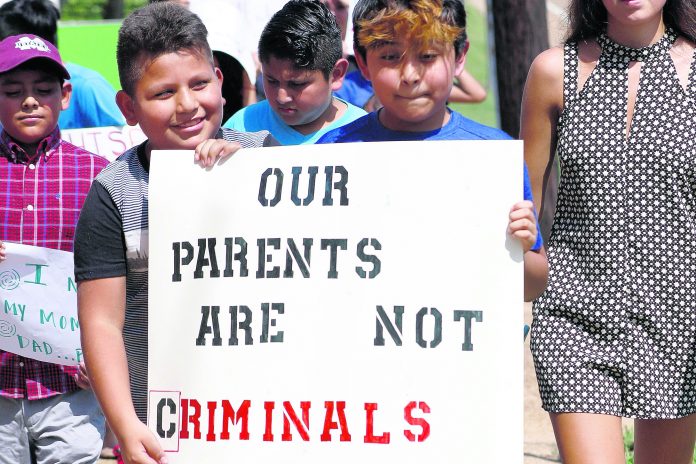
The Trump administration is on a course to remake the face of immigration in America in ways that would turn it whiter and wealthier.
It is a dramatic editing of the American catechism welcoming “your tired, your poor, your huddled masses, yearning to breathe free,” inscribed on the Statue of Liberty, to “your tired and your poor who can stand on their on their own two feet and will not become a public charge.”
The administration official who offered that rewrite, Ken Cuccinelli, acting director of U.S. Citizenship and Immigration Services, affirmed on Wednesday that his words were intentional, including his added notion that the poem was written for Europeans. He said in a statement that his agency “is tasked with enforcing the law, not a poem.”
It’s another defiant step in President Donald Trump’s long march to change the way the nation thinks about immigrants, an approach he hopes will win over enough voters to earn him a second term. He’s added another layer of certainty that the 2020 campaign will be deeply rooted in a cultural battle over national identity.
But he faces an accompanying danger that his hard line will further energize Democrats, alienate suburban women and prompt a swell of newly registered Latino voters. Democrats have been quick to charge that the enforcement pivot the administration announced on Monday — to block many legal immigrants who receive public benefits from being granted green cards — was rooted in sowing racial animus.
“This administration finally admitted what we’ve known all along: They think the Statue of Liberty only applies to white people,” tweeted former Texas Rep. Beto O’Rourke, a Democratic presidential candidate.
The president and his aides “have further stained this country’s tradition as a beacon of hope for immigrants,” said Hispanic Federation President José Calderón. “Shame on them.”
Depending on how the new “public charge” rules are applied, experts say that changes intended to predict whether applicants are likely to use public benefits could dramatically alter the makeup of immigrants eligible for green cards or permanent residency in the U.S. by taking into account their incomes, ages and employment histories.
According to a study by the nonpartisan Migration Policy Institute, the rules would likely reduce immigration from Mexico and Central America, while increasing it from other regions, especially Europe. The income standards, in particular, could lead to reduced rates for Mexican, Central American, Caribbean, African and Asian applicants. Canadian and Austrian applicants could likely benefit, as could applicants from non-white countries like India and Japan.
The study also found the new rules would have put most recent legal permanent residents at risk of denial, with 69 percent of the past five years’ green card recipients displaying at least one of the “negative factors” identified by the government. The rules are also likely to make it harder for the parents of U.S. citizens to join their children in the country because they’re more likely to be older, not working and facing health challenges.
“America’s always been a path to success for millions of people and now America wants to make it so that it’s a path only for those who have already succeeded,” said Aaron Reichlin-Melnick, a policy analyst at the American Immigration Council.
Trump rose to the White House fanning unease about an increasingly diverse nation, where demographic and immigration trends are projected to make whites a minority in less than two decades. As Trump told it, immigrants were stealing his supporters’ jobs and driving down their wages, denying working class whites opportunities for success.
Immigrants were effective scapegoats, especially in towns in the industrial heartland and other economically depressed areas of the country still reeling from job losses as the rest of the country was experiencing an economic recovery. And Trump has continued to push that message.
His administration has tried to severely limit the number of migrants claiming asylum in the U.S. and has dramatically reduced refugee admissions — with further reductions possible next month when refugee limits for next year are unveiled. He has also endorsed legislation that would slash legal immigration rates, while at the same time pushing for a wholesale overhaul of the kinds of immigrants who should be permitted, favoring those with certain skills and high-wage job offers over those with family ties to the U.S.
Blunted by Democrats in Congress, he has turned to administrative action, with mixed results withstanding legal challenges.
In addition to the changes he’s made and proposed, Trump has spoken disparagingly about immigration from majority black and Hispanic countries, including calling Mexican immigrants rapists and criminals when he launched his 2016 campaign. Last year, he privately branded Central American and African nations as “shithole” countries and he suggested the U.S. take in more immigrants from European countries like predominantly white Norway.
Immigration official Cuccinelli seemed to limit the reach of the Statue of Liberty poem in an interview with CNN on Tuesday night. He said it was referring to “people coming from Europe where they had class-based societies where people were considered wretched if they weren’t in the right class.”
His own agency seems to like the original. In its “citizen almanac” for distribution to new Americans, the agency applauds the poem as a beacon for “the millions of immigrants who came to America in search of freedom and opportunity.”q



















